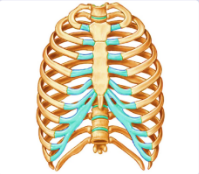
Identify and write the names of the bones and joints present in this structure.


Answer
540.6k+ views
Hint: The rib cage is the arrangement of bones that are attached to the vertebral column and thorax of almost all vertebrates and provides protection to the heart and lungs.
Complete answer:
The ribs are classified on the basis of their location and also connection to the sternum. The ribs that are directly attached to the sternum are termed true ribs and the ones not directly attached to the sternum are termed false ribs, and all the ribs are attached to the vertebrae. The total number of ribs are twelve and each rib consists of the head, neck and shaft region. The first rib is the most curved one with a small head and attached to the first thoracic vertebra.
The second rib is attached to the sternum by the help of the costal cartilage. The ninth rib is at the same level with the first lumbar vertebrae and this level is called the transpyloric plane. The eleventh and twelfth rib are termed as floating ribs as they are not attached to the sternum at all.
The sternum is a flat bone that makes up the front of the rib cage where the true ribs join. The jugular notch is present at the top of the manubrium, which is a part of the sternum and the clavicular notch is located on either side of the manubrium. The xiphoid process is a cartilage located at the lower side of the sternum and not attached to any ribs.

Note: The rib cage is not only needed for protection of the lungs and heart but also plays an important role in the respiratory system of humans. Damage to the rib cage like fracture is life threatening. Dislocation of ribs is caused commonly and is also very painful.
Complete answer:
The ribs are classified on the basis of their location and also connection to the sternum. The ribs that are directly attached to the sternum are termed true ribs and the ones not directly attached to the sternum are termed false ribs, and all the ribs are attached to the vertebrae. The total number of ribs are twelve and each rib consists of the head, neck and shaft region. The first rib is the most curved one with a small head and attached to the first thoracic vertebra.
The second rib is attached to the sternum by the help of the costal cartilage. The ninth rib is at the same level with the first lumbar vertebrae and this level is called the transpyloric plane. The eleventh and twelfth rib are termed as floating ribs as they are not attached to the sternum at all.
The sternum is a flat bone that makes up the front of the rib cage where the true ribs join. The jugular notch is present at the top of the manubrium, which is a part of the sternum and the clavicular notch is located on either side of the manubrium. The xiphoid process is a cartilage located at the lower side of the sternum and not attached to any ribs.

Note: The rib cage is not only needed for protection of the lungs and heart but also plays an important role in the respiratory system of humans. Damage to the rib cage like fracture is life threatening. Dislocation of ribs is caused commonly and is also very painful.
Recently Updated Pages
Why are manures considered better than fertilizers class 11 biology CBSE

Find the coordinates of the midpoint of the line segment class 11 maths CBSE

Distinguish between static friction limiting friction class 11 physics CBSE

The Chairman of the constituent Assembly was A Jawaharlal class 11 social science CBSE

The first National Commission on Labour NCL submitted class 11 social science CBSE

Number of all subshell of n + l 7 is A 4 B 5 C 6 D class 11 chemistry CBSE

Trending doubts
What is meant by exothermic and endothermic reactions class 11 chemistry CBSE

10 examples of friction in our daily life

One Metric ton is equal to kg A 10000 B 1000 C 100 class 11 physics CBSE

1 Quintal is equal to a 110 kg b 10 kg c 100kg d 1000 class 11 physics CBSE

Difference Between Prokaryotic Cells and Eukaryotic Cells

What are Quantum numbers Explain the quantum number class 11 chemistry CBSE




